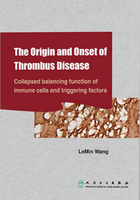
上QQ阅读APP看书,第一时间看更新
Chapter 2 The answer to the onset of acute venous thrombus
1.Questions from clinics
Venous thromboembolism (VTE) includes pulmonary thromboembolism (PE) and deep venous thrombosis (DVT). Venous thromboembolisms that could be diagnosed in clinics are called dominant VTE. The clinical spectrum of VTE is relatively wide, because VTE can occur in different organs and tissues. However, dormant VTE that is hard to be diagnosed in clinics is often found in autopsy. VTE, including cerebral cortical vein, cerebral venous sinus thrombosis, acute PE, chronic thromboembolic pulmonary hypertension (CTEPH), hepatic venular occlusive disease, Butchart's syndrome,mesenteric venous thrombosis, pelvic venous thrombosis, DVT and PE after surgeries as well as clinically common lower limb DVTs, distributes in diverse clinical disciplines and is a disease faced by almost all the clinical disciplines. Among them, PE has become a global medical care problem due to its high morbidity, misdiagnosis rate and mortality[1, 2]. VTE can be divided into two categories, genetic VTE and acquired VTE. According to the results of epidemiological investigations, the incidence of genetic VTE is relatively low, while most of the VTEs are acquired VTEs. Both of them can be called symptomatic VTE (Figure 2-1-1,2,3) and are hard to be distinguished.

Figure 2-1-1 Simulation diagram of pulmonary thromboembolism

Figure 2-1-2 Simulation diagram of Iliac vein thrombosis

Figure 2-1-3 Simulation diagram of lower extremity deep venous thrombosis
Many risk factors of VTE have been identified by organizations such as the American College of Chest Physicians (ACCP), which has published nine editions of guidelines for VTE diagnosis [3], treatment and prevention from 1995 to 2012. Proposed VTE risk factors include advanced age, infection, malignancy, autoimmune disease,surgery, trauma, pregnancy, long trip syndrome, family history and so on. ACCP has raised the risk stratification of surgical patients. Different measures should be taken in patients with different stratification to prevent VTE. Actually, only a small part of the patients with same risk stratification and same external environment have had VTE. In 2008, Shackfore [4] reported that 84% of the 37619 surgical patients were partly or totally treated and prevented according to the guideline. From 1995, when the first ACCP was published, to 2004, the numbers of symptomatic VTE increased rather than decreased,and there was segregation between preventing risk factors and VTE occurrence.
Thus, here the questions come. Why does the incidence of VTE increase as the age increases? Why does the incidence of VTE stay high in patients with malignancies? Why does only a small part of patients with the same infection develop VTE? Sudden death caused by acute PE resulting from surgeries, pregnancy, delivery or long trip syndrome is always hard to prevent. However, the vast majority of the population will not develop VTE under the same conditions. Both being thrombus, acute arterial thrombus is white thrombus but acute venous thrombus is red thrombus. What does the pathological difference mean? Thrombolytic therapy is effective for arterial thrombosis within several hours after onset, but venous thrombosis, with a wide thrombolytic time window, can be delayed to several days, 2 weeks, or even longer. What causes the difference in the thrombolytic time window between acute venous and acute arterial thrombus? Acute venous thrombus can autolyze, while arterial thrombus cannot. For VTE patients, oral anticoagulants are usually recommended for 3, 6 or 12 months and occasionally lifelong. Currently, there are no objective criteria for individual evaluation that complicates the selection of anti-coagulation therapy by physicians. Furthermore, even with standard anti-coagulation therapy and international normalized ratio (INR), some patients still develop CTEPH. Thus, the physicians are extremely puzzled about anticoagulant usage.
Query raised in clinics usually originates from clinical practices. The risk factors of VTE are only the clinical phenomenon of incident VTEs and the summary of evidencebased medicine, not the essence of this disease. So far, the medical resources put into the global prevention of VTE have not had the predicted effects. The reasonable explanation of this separation phenomenon between clinical prevention and treatment guidelines of VTE and clinical practices is that the etiology and pathogenesis of VTE are still unclear.